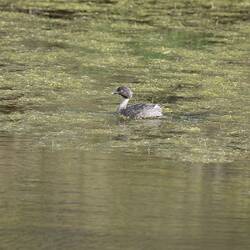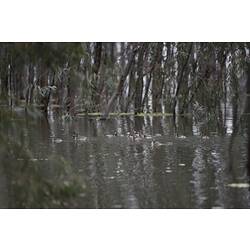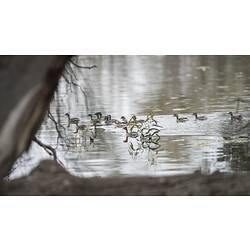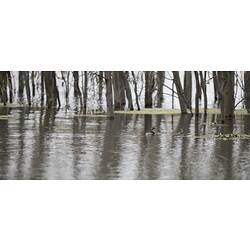General Description
A small, stocky grebe. Upper body pale brown to grey, underparts creamy white, eye white. Breeding adults have a black head with distinctive narrow grey-white stripes and a black stripe down the back of the neck (nape). Juveniles have a white throat and chin and a striped face. Bill to tail length is up to 28 cm.
Biology
Hoary-headed Grebes form pairs and nest in colonies on aquatic vegetation. They are generally located well away from the shoreline. Nests are a platform of waterweeds, attached to objects such as fallen branches or reeds. Eggs tend to lie in water and parents use wet vegetation to cover the eggs when they leave, making the nest appear empty. The usual clutch size is two to four eggs and both parents incubate them. They feed throughout the day by diving to catch aquatic invertebrates. Will forage only on the water surface when light levels are low. They can be found in large flocks on water in the dry season and over winter. They tend to be silent.
Distribution
Mainland Australia and Tasmania.
Habitat
Brackish or salt water wetlands and dams.
More Information
-
Animal Type
-
Animal SubType
-
Brief Id
A small dark grey and white grebe. Distinctive black head with white streaks during the breeding season.
-
Colours
Brown, White
-
Maximum Size
28 cm
-
Habitats
-
Diet
Carnivore
-
Diet Categories
Crustaceans
-
Endemicity
-
Commercial
No
-
Conservation Statuses
CITES: Not listed, FFG Threatened List: Not listed, EPBC Act 1999: Not listed, IUCN Red List: Least Concern
-
Taxon Name
-
Common Name
Hoary-headed Grebe
-
Kingdom
-
Phylum
-
Subphylum
-
Class
-
Subclass
-
Superorder
-
Order
-
Family
-
Genus
-
Species Name
poliocephalus



























